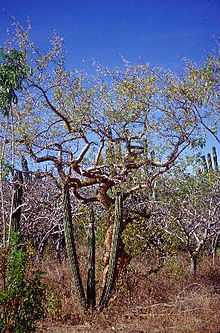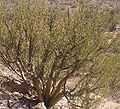Bursera microphylla
| Bursera microphylla | |
|---|---|
 | |
| Scientific classification | |
| Kingdom: | Plantae |
| (unranked): | Angiosperms |
| (unranked): | Eudicots |
| (unranked): | Rosids |
| Order: | Sapindales |
| Family: | Burseraceae |
| Genus: | Bursera |
| Species: | B. microphylla |
| Binomial name | |
| Bursera microphylla Gray[1] | |
 | |
| Natural range of Bursera microphylla | |
| Synonyms | |
|
Elaphrium microphyllum (A. Gray) Rose[1] | |
Bursera microphylla belongs to the family Burseraceae in the order Sapindales. Bursera microphylla, known by the common name elephant tree in English or 'torote' in Spanish, is a tree in genus Bursera. It grows into a distinctive sculptural form, with a thickened, water-storing or caudiciform trunk. It is narrowly distributed in the United States in the Anza-Borrego Desert State Park region and the Santa Rosa Mountains in Southern California as well as parts of Southwestern Arizona.[2]
Distribution
The distribution of Bursera microphylla is very similar to that of the Sonoran Desert overall.[3] Bursera microphylla is the most northerly member of the Burseraceae in North America and also perhaps the most xeromorphic species within the genus as it thrives in the extremely arid desert hills and mountains in northwest Sonora. This tree is native to Northern Mexico, in the states of Baja California, Baja California Sur, Sinaloa, Sonora and Zacatecas;[1] and the Southwestern United States, in Southern California and Arizona); especially desert ecoregions.
Description
Bursera microphylla is generally a small tree with a thickened trunk and relatively small branching structure in comparison to the trunk size; it is semi-succulent and store water in the conductive and parenchymal tissues of the trunk, lower limbs, and wood.[4] Shreve (1964) classified the plant as a sarcocaulescent tree. The sarcocaulescent habit acts as a buffer against variation in environmental water balance (Turner et al., 1995). The leaves are alternate, without stipules, and are mostly once-pinnate or twice-pinnate but can be unifoliate or trifoliate in some species (Rzedowski and Kruse 1979). Bursera microphylla reaches up to 10 m (33 ft)[5] in height and its bark is light gray to white, with younger branches having a reddish color. The light foliage is made up of long, straight, flat, legume-like leaves which are composed of paired leaflets. It flowers in rounded yellow buds which open into small, star-shaped, white or cream flowers. The fruit is a drupe containing a yellow stone.[6]
The leaves are characterized as deciduous, including those on species that occur in tropical subhumid and humid forests (Becerra 2005). As a response to rain and warmer temperatures, B. hindsiana, B. laxiflora, and other more tropical species in Sonora begin to leaf out at any time of the year (Johnson 1992). Most species are drought deciduous, but B. microphylla keeps its leaves year-round, except under conditions of drought and cold weather. Most of the Sonoran Burseras flower in June and July, just before or just as the leaves are produced. This is probably in response to a lack of rainfall earlier in the summer before the monsoon season as this species is found in the region of Sonora lies at the western edge of an area, which regularly experiences summer monsoon storms. The fruits of species in the genus Bursera are small, drupe-like with a single-seed (Felger et al. 2001). In B. microphylla, the fruits develop rapidly and ripen gradually, a few at a time, and in some species many fruits remain on the trees as they begin to flower the following summer (Johnson 1992). Birds appear to be primarily responsible for seed dispersal in Bursera. Gray Vireos and Ash- throated Flycatchers feed heavily on the ripe fruits of B. microphylla in the Puerto Lobos region of Sonora, Mexico during the winter months (Johnson 1992). The winter range of the Gray Vireo in Sonora closely matches the distribution of Bursera microphylla (Bates 1992). Birds do not appear to eat the unripe fruit (Johnson 1992). Rodents sometimes gather fruits and seeds of Bursera. Ants have been observed carrying away seeds of B. microphylla (Johnson 1992). The exfoliating papery bark of many of the trivalvate species may serve to attract the attention of birds and other animals from a distance as it rustles in the breeze (Rzedowski and Kruse 1979).
Uses
- The Cahuilla Indian people of the Colorado Desert region of California, according to legend, used the red sap of the elephant tree as a panacea.
- Seri use the plant in many ways, including the wood for boxes.[7]
- It is popular as a landscape plant in southwestern US in low warm desert where it does not freeze.[8]
Gallery
-

Bursera microphylla on southern slope at South Mountain Municipal Park, Phoenix, Arizona. October 2008. (C. Cordova)
-

Bursera microphylla growing on a granite boulder at South Mountain Municipal Park, Phoenix, Arizona. October 2008. (C. Cordova)
-

Bursera microphylla growing on a granite boulder at South Mountain Municipal Park, Phoenix, Arizona. January 2010. (C. Cordova)
-

Bursera microphylla growing on a granite boulder at South Mountain Municipal Park, Phoenix, Arizona. January 2010. (C. Cordova)
-

Bursera microphylla growing on granite boulders at South Mountain Municipal Park, Phoenix, Arizona. January 2010. (C. Cordova)
-

Bursera microphylla in Baja California, Mexico
-

Bursera microphylla in the Sonoran Desert, Arizona, U.S.
-

Bursera microphylla in the Vizcaino Desert, Baja California Sur, Mexico
See also
References
- ↑ 1.0 1.1 1.2 "Bursera microphylla information from NPGS/GRIN". www.ars-grin.gov. Retrieved 2009-01-11.
- ↑ desertusa.com
- ↑ Mooney HA, Emboden WA Jr (1968). "The relationship of terpene composition, morphology, and distribution of populations of Bursera microphylla (Burseraceae)". Brittonia 20: 44–51.
- ↑ Turner RM, Bowers JE, Burgess TL (2005). Sonoran Desert Plants: An Ecological Atlas. Tucson: University of Arizona Press. p. 501. ISBN 978-0816525195.
- ↑ Jepson Manual Treatment — Bursera microphylla
- ↑ C. Michael Hogan. 2009
- ↑ Fleger, R.S. & M.B. Moser. 1992. People of the Desert and Sea: Ethnobotany of the Seri Indians. University of Arizona Press.
- ↑ Soule, J.A. 2013. Success with Succulents. Tierra del Sol Press
Notes
- "Elephant Tree (DesertUSA)". desertusa.com. Retrieved 2010-10-03.
- C. Michael Hogan. 2009. Elephant Tree: Bursera microphylla, GlobalTwitcher.com, ed. N. Stromberg
- Cordova, Cesar. 2011. Bursera microphylla in South Mountain Municipal Park: Evaluating its Habitat Characteristics Arizona State University M.S. Thesis.
| Wikimedia Commons has media related to Bursera microphylla. |
External links
- Jepson Manual Treatment — Bursera microphylla
- USDA Plants Profile: Bursera microphylla (Elephant tree)
- Bursera microphylla — U.C. Photo gallery
- Desert-tropicals.com: Bursera microphylla